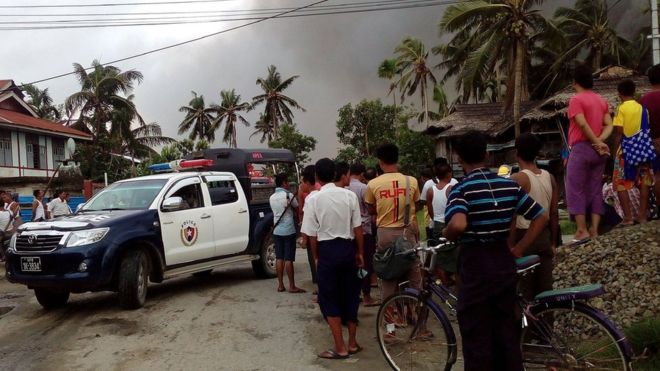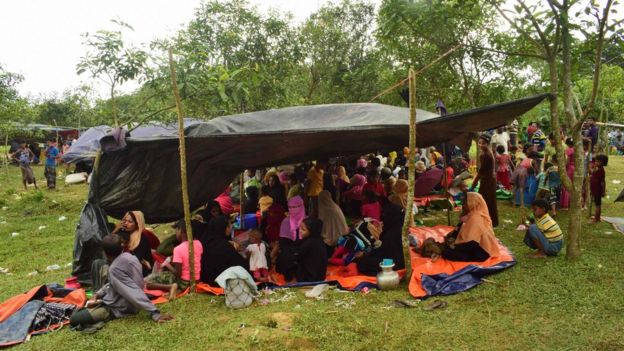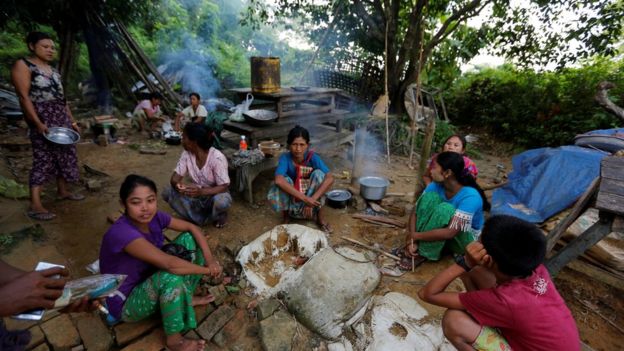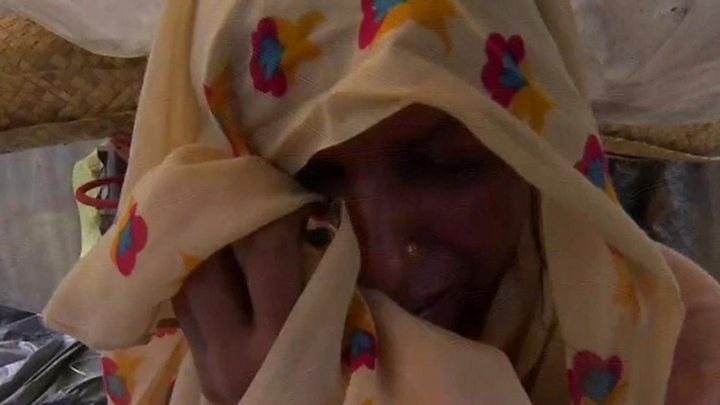Myanmar: What Sparked Latest Violence in Rakhine?
A fresh outbreak of violence in Myanmar’s Rakhine state has caused thousands of Rohingya civilians to flee towards Bangladesh.
The exodus began on Friday after Rohingya militants attacked police posts, killing 12 members of the security forces. Dozens of militants are reported to have been killed in both those and subsequent clashes.
When similar attacks on police posts took place last year, Myanmar’s military launched a crackdown on the Rohingya that led to claims of severe human rights abuses.
As thousands try to cross the border, the UN has urged Myanmar’s authorities to protect all civilians “without discrimination”.
Deep-seated tensions between the Muslim Rohingya and the majority Buddhist population in Rakhine have led to deadly communal violence in the past.
When did the latest violence start?
On Friday Rohingya insurgents armed with knives and home-made bombs attacked more than 30 police posts in northern Rakhine, the government said.
More clashes are reported to have taken place over the weekend, displacing thousands of civilians from both communities. There are also reports of civilian deaths.
Human Rights Watch says satellite data shows widespread fires in at least 10 areas. The government said militants burned down “minority-ethnic villages”, while the militants attributed the blazes to the security forces and local Buddhists.
Journalists’ access to Rakhine state is severely restricted, making it hard to confirm details, but a Bangladesh Border Guard official told AFP news agency on Tuesday: “Last night we heard heavy gunfire by automatic weapons in phases and saw smoke billowing from burnt villages across the border”.
What is the situation at the border?
The UN refugee agency said that by Sunday 5,200 Rohingya had fled to Bangladesh since Friday’s violence. It said “several thousand” were in locations along the Myanmar side of the border and more were cordoned off in areas just inside Bangladesh.
Most of those at the border were women and children, and there were reports of wounded people among them.
There are also multiple reports of people being prevented from crossing the border. In a statement on Monday, UN Secretary General Antonio Guterres urged Bangladesh to continuing allowing Rohingya to seek safety.
Bangladesh is already home to hundreds of thousands of Rohingya refugees who have fled previous outbreaks of violence in Myanmar.
Inside Myanmar, there are also reports of Rakhine Buddhists moving south to escape the violence.
Who are the militants?
A group called the Arakan Rohingya Salvation Army (Arsa) says it carried out Friday’s attacks. The group first emerged in October 2016, when it carried out similar assaults on police posts, killing nine police officers.
It says its primary aim is to protect the Rohingya Muslim minority from state repression in Myanmar.
The government says Arsa is a terrorist group whose leaders have been trained abroad. Its leader is Ata Ullah, a Rohingya born in Pakistan who was raised in Saudi Arabia, according to the International Crisis Group.
But a spokesman for the group told Asia Times that it had no links to jihadi groups and that its members were young Rohingya men angered by events since communal violence in 2012.
What are the Rohingyas’ grievances?
Myanmar’s government claims the Rohingya are illegal immigrants from Bangladesh and denies them citizenship, even though many say they have been there for generations.
Many are living in temporary camps after being forced from their villages by the wave of communal violence that swept Rakhine in 2012. They live in one of Myanmar’s poorest states, and their movements and access to employment are severely restricted.
In the wake of the militant attacks of October 2016, many Rohingya accused the security forces of rape, killings, burning villages and torture during the military crackdown that followed. More than 80,000 fled into Bangladesh.
The UN human rights body, in a report, said “devastating cruelty” had taken place. The UN is now carrying out a formal investigation, although the military denies wrongdoing.
On Tuesday UN human rights chief Zeid Ra’ad Al Hussein called the latest violence deplorable but said it could have been predicted and prevented.
“Decades of persistent and systematic human rights violations, including the very violent security responses to the attacks since October 2016, have almost certainly contributed to the nurturing of violent extremism, with everyone ultimately losing,” he said.
Courtesy : bbc

 Image captionThousands of Rohingya, mainly women and children, have fled to Bangladesh since Friday
Image captionThousands of Rohingya, mainly women and children, have fled to Bangladesh since Friday Image captionRakhine Buddhists have also left their homes to head to safer parts of the state, reports say
Image captionRakhine Buddhists have also left their homes to head to safer parts of the state, reports say


